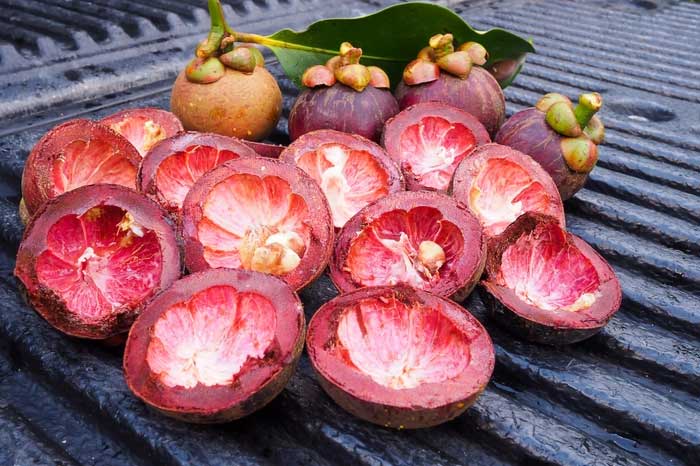The rind of the mangosteen is known for its numerous health benefits, particularly rich in antioxidants, anti-inflammatory compounds, anti-cancer properties, and has antiviral, antibacterial, antifungal, antihistaminic, and other beneficial characteristics due to its high content of bioactive compounds such as xanthones, anthocyanins, phenols, and tannins.
Mangosteen is dubbed the “queen of fruits” as it is one of the tropical fruits with high nutritional value, beloved for its sweet, refreshing taste. Besides the edible fruit inside, the rind of the mangosteen contains many beneficial extracts for health, even boasting a higher antioxidant content than the flesh itself.
1. Nutritional Value of Mangosteen Fruit and Rind
Mangosteen is relatively low in calories but offers many essential nutrients for the body:
- Fiber
- Fat
- Protein
- Vitamin C
- Vitamin B9 (folate)
- Vitamin B1 (thiamine)
- Vitamin B2 (riboflavin)
- Manganese
- Copper
- Magnesium
The vitamins and minerals in mangosteen are crucial for maintaining numerous bodily functions, including DNA production, muscle contraction, wound healing, immune response, and nerve signaling.
The rind of the mangosteen also contains several vitamins and nutrients beneficial for health, but it is particularly notable for compounds such as tannins, resins, mangostin, and xanthones.

Both the inner fruit and rind of mangosteen contain beneficial nutrients for health. (Image: ST)
2. Health Benefits of Mangosteen Rind
Traditionally, mangosteen rind has been used as a remedy for stomach aches, skin inflammation, and treating wounds in animals. In Traditional Chinese Medicine, mangosteen rind is sour and bitter, with a neutral nature, entering the lung and spleen meridians, and is effective in treating diarrhea and food poisoning.
Currently, many studies have been conducted reporting that mangosteen rind contains numerous compounds with biological activity and potential health applications.
2.1. Antioxidant Properties
Among fruit rinds, mangosteen rind is a significant source of natural phenolic antioxidants. It contains various bioactive compounds, such as phenolic acids and flavonoids, which have biological and medicinal properties, especially antioxidant characteristics.
Notably, Associate Professor Dr. Suthasinee from Chulalongkorn University in Thailand has conducted research on mangosteen rind and discovered xanthones—compounds within the flavonoid group that combat or prevent various infections with properties such as anti-cancer, antibacterial, anti-allergic, anti-inflammatory, and antioxidant effects.
There are 40 xanthones found in mangosteen rind, with the most prevalent being alpha-mangostin, beta-mangostin, and gamma-mangostin.
Additionally, phytochemicals found in mangosteen rind, including garcinone, mangostin, isomangostin, and garcimangosone, have been reported to exhibit antioxidant, anti-proliferative, anti-inflammatory, and anti-cancer activities.

The most notable benefit of mangosteen rind is its antioxidant capability, preventing various diseases. (Image: ST).
2.2. Improves Certain Skin Conditions
The rind of the mangosteen contains several vitamins and nutrients that help prevent aging, reduce wrinkles, nourish cells, repair tissues, and significantly improve skin elasticity.
Moreover, mangosteen rind is also used as a mask for skin care or to support the treatment of dark spots, freckles, and acne.
2.3. Good for Oral Health
The xanthones in mangosteen rind exhibit antibacterial and anti-inflammatory properties. Therefore, using mangosteen rind as a mouthwash can help reduce bad breath, prevent harmful bacteria from affecting the gums and teeth, and can even assist in whitening teeth.
3. How to Use Mangosteen Rind
People can use mangosteen rind tea to reap health benefits. The preparation is quite simple:
- First, wash the mangosteen rind clean, cut it into small pieces, and dry it in the sun or in a dehydrator until completely dry. When drying, be careful to store it properly to avoid mold, which can cause poisoning if consumed.
- Next, you can brew it in warm water, similar to making regular tea. You may add a bit of rock sugar or honey to make it more palatable.
If you do not have time to dry or dehydrate, you can boil fresh mangosteen rind to make a drink.

Mangosteen rind can cause some side effects.
4. Precautions When Using Mangosteen Rind
While mangosteen rind offers certain health benefits, it may also cause some side effects. Therefore, when using this fruit rind, one should be aware of the following:
- Since mangosteen rind contains tannins, resins, and bitter compounds, it may bind with proteins to form precipitates. This can lead to difficulty in absorbing nutrients from other foods and inhibit certain digestive enzymes, making digestion difficult. Thus, one should not consume excessive amounts of products made from mangosteen rind.
- It is preferable to use dried mangosteen rind rather than fresh rind to avoid potential poisoning or constipation.
- If you have allergies or any health issues, it is advisable to consult a doctor before using mangosteen rind.
- The xanthone compounds in mangosteen may affect blood coagulation. Therefore, avoid using mangosteen rind about two weeks prior to surgery or consult with a physician for further advice.
Exploring the Origins of Mangosteen – A Fruit Trending on Social Media for Unique Salad Dishes


















































